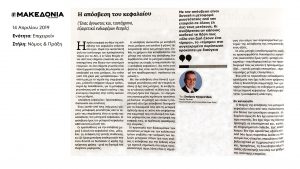The first reference to the issue of the amortization of capital dates, back, to 1920 – in the original text of the previous Law on Sociétés Anonymes (: Law 2190/1920). The Patriarch of the Law of Sociétés Anonymes I. Passias in the first volume of his monumental work (“The Law of the Société Anonyme”) referred to it giving its historical dimension.
The legislative regulation of this issue, after more systematically dealing with it (in the second phase of its “life”), dates thirty-five years. Yet, despite its centuries-old life, this institution is, however, the least well-known and well-established institutions in the law of sociétés anonymes. And as little is known, so profitable it could prove to be for the shareholders. This is because in our country we “confuse” (often – without really needing) our pocket with the fund of our company, although there are other legitimate (and not just legitimate) ways of transferring liquidity from that fund (: of the société anonyme) in the pocket of his (the shareholders). In the broader known legal ways, one could include profit distribution and share capital amortization.
So, what is the amortization of capital? Could it constitute a decrease?
One of the legitimate ways of transferring liquidity from the company’s fund is also the amortization of the share capital. The legislator “felt” the need (albeit, as it is known, an insoluble one) to note, in one – separate paragraph of the relevant provision, that “amortization does not constitute a decrease of the capital”. But why did he need to make this specific clarification? Reasonable, as the question of “decrease?” was created in each of us when we first came into contact with this particular institution.
Therefore, the amortization of the share capital does NOT constitute a decrease. The decrease of the share capital results in its reorganization – its dilution, i.e. by the amount decided by the General Meeting and its determination at a new, lower level.
It is important to repeat that the amortization does NOT affect the share capital, which remains stable even after amortization.
The conditions for the amortization
The conditions for the amortization (partial or total of the share capital) are, just, two:
(a) For the commencement of the relevant procedure: Decision of the General Meeting either with increased quorum and majority or (if there is a statutory provision) with a simple quorum and majority and
(b) For the implementation of the relevant decision: Use of reserves or amounts of profits for the current year (see immediately below).
The implementation of the amortization
In accordance with the law, the amortization is implemented, by paying to the shareholders all or part of the nominal value of their shares. However, the specific payment is made (not with capital dilution but) by using special reserves that can be distributed. For the sake of completeness, this payment could of course also take place from the remaining profits of the year after the distribution of the first dividend, the formation of the statutory reserve and (of course) the payment of the due tax. Due to the fact that the money paid to the shareholder in the context of amortization is not taken from the share capital, its naming (“capital amortization”) is rather unfortunate. Rather right as it is the one that creates the above-mentioned reflection (: “i.e. decrease?”).
Beneficiaries and the “price”
Amortization does not (necessarily) benefit all shareholders. With amortization, it is possible to transfer liquidity from the company to either all or only certain shareholder / shareholders.
It is said that “everything in life comes with a price”. Regardless of whether a person adopts this position in general, the “price” in this case is clear: Shareholders whose shares have been amortized retain their rights from the equity relationship but not those relating to their participation in the distribution of the first dividend and their right to reimbursement for their contribution if the company is liquidated.
Therefore: The right to the first dividend is limited to those only from shares for which no amortization of their nominal value has taken place. The excess of the minimum dividend is allocated to all the shares, including those whose nominal value is written off. As regards the right to the distribution of the proceeds of the liquidation, the other shares (except for those for which the amortization) are preceded and then the excess is distributed in the totality of the shares (thus, the shares whose nominal value has been written off).
The distinction of shares
After the amortization of the nominal value of some shares, their share options are differentiated (better: diluted) in relation to the others. The protection of the rights of the remaining shares and of the bona fide third parties imposes (albeit not foreseen in the law) two alternative options: (a) the cancellation of the old (full rights) shares in combination with the issuance of new – with a respective note to their bodies or, more simply, (b) the note on the body of the specific shares of the amortization of their nominal value.
In any case, the new shares (diluted by the aforementioned rights) are in practice and theoretically also called (incomprehensible to why so) “jouissance shares” – in addition to identifying them as common or privileged (i.e: “common jouissance shares” or where appropriate, “privileged jouissance shares”).
The participation of “jouissance shares” in a possible decrease of the share capital
The relevant question was put to the writer, in more than one case, by entrepreneurs who, with much interest, listened to the description of the particular institution. It is true that this particular issue does not seem to have been particularly dealt with in theory and by case law. On the occasion of the repetition of the relevant institution in the new Law on Sociétés Anonymes, as well as the discussions in the previous paragraph, diametrically opposed views were heard. I have no doubt that the better one is the one that recognizes the right of participation of jouissance shares in a consequential decrease of the share capital, which may take place with the return of part of the capital to shareholders. Argumentation in this direction has two very important axes:
(a) The (non-disputable) wording of the law, which restrictively refers to the rights that the jouissance shares are deprived of (among which the right to participate in a decrease through the payment of a part of the capital to the shareholders, is not included) and
(b) The fact that the return to the shareholders of the amortization product takes place either through the use of special reserves that are permitted to be distributed or by using profits for the current year after the first dividend and the formation of the statutory reserve – therefore the “share capital” account, which (in any case) remains unchanged after the amortization, is not used.
The “restoration” of jouissance shares to the status before the amortization
One more, extremely interesting, question the writer has accepted in one of the presentations of this particular institution is the possibility that jouissance shares returned to their pre-existing status. This question (due to the limited application of the institution) does not seem to have been dealt with by case law – nor in theory. But for the answer with (relative) ease, we could positively (that is, in favor of the validity) accept the assumption that such a possibility is not forbidden by law. However, reservations are made as regards the accounting management of the whole matter as the return (permanently) of distributed reserves does not appear to be an acceptable solution.
In conclusion
The institution of the amortization of the share capital is an old institution of the law of sociétés anonymes. However, since it has not become widely known, it has not received the adequate attention at the scientific and, most importantly, business level. As a result, it has not been sufficiently exploited. However, from the above, I do not think there is any doubt about its usefulness or the possibility of multi-level exploitation for the shareholders of the société anonyme.

Stavros Koumentakis
Senior Partner
P.S. A brief version of this article has been published in MAKEDONIA Newspaper (April 14th, 2019).

